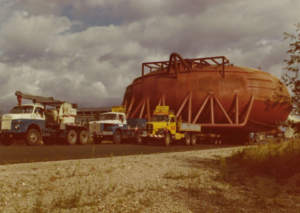The Construction Process

Alexander L. Kielland was a so-called Pentagon rig. This was a semi-submersible drilling rig with five legs, hence the name “pentagon” meaning five. Alexander L. Kielland, with the identification number P89, was one of eleven rigs with the same design. [REMOVE]Fotnote: Official Norwegian Reports: 11: 1981, p. 29. https://media.digitalarkivet.no/view/105511/28
This type of rig was developed through a collaboration between the Institut Française du Pétrole and the Schlumberger company Forex Neptune. The aim was to create a platform rig capable of drilling in demanding weather conditions. The construction process started after an extensive research collaboration that began in 1963.
When Alexander L. Kielland was built, the parts for the rig were made by various subcontractors. Everything was transported to the CFEM shipyard in Dunkirk, France where the rig was assembled. The struts were manufactured by the subcontractor Ets. J. Richard-Ducros in Alès, a reputable company that had never before supplied components to the offshore industry.[REMOVE]Fotnote: Official Norwegian Reports: 11: 1981, p. 33. https://media.digitalarkivet.no/view/105511/32

The construction process at the French shipyard was closely monitored by inspectors and professionals from Stavanger Drilling, Institut de Soudure and Det Norske Veritas.[REMOVE]Fotnote: Interview with Engineer Chisten Magne Jensen. 3.2.16. Memory Bank. Among those present were platform manager Torstein Sæd, platform manager Rolf Halvorsen, technical manager Leif Barkved, technical manager Sverre Karl Kristensen, technical supervisor Christen Magne Jensen, as well as engine room operator Kåre Magne Kvåle and control room operator Tormod Wigestrand from Stavanger Drilling.[REMOVE]Fotnote: Interview with Engineer and former DNV-technical supervisor in Stavanger Drilling, Christen Magne Jensen. 3.2.16. Memorybank; engine room operator Kåre Magne Kvåle 9.11.2015; control room operator Tormod Wigestrand 11.7.2016. Memory Bank.
The subcontractor Richard-Ducros had both the welding procedures and the welders’ qualifications approved by the classification society Veritas. Before leaving the shipyard, the fillet weld at the hydrophone was thoroughly checked using penetrating fluid, under the supervision of Veritas. To ensure the quality of the welds, X-ray photography of the weld seams was carried out by experts from Institut de Soudure on behalf of Stavanger Drilling.[REMOVE]Fotnote: Official Noregian Reports: 11: 1981, p. 32 https://media.digitalarkivet.no/view/105511/32
Explore more:
Here you can find a report, dated September 1974, in which C.F.E.M. reports on the progress of the construction process: https://media.digitalarkivet.no/view/90929/229
Chronological overview of Det Norske Veritas’ involvement on Kielland. https://media.digitalarkivet.no/view/105510/2
Read more about the construction of Kielland in the Norwegian Official Reports 1981:11 https://media.digitalarkivet.no/view/105511/47
Who were the owners of the Kielland rig?arrow_forward